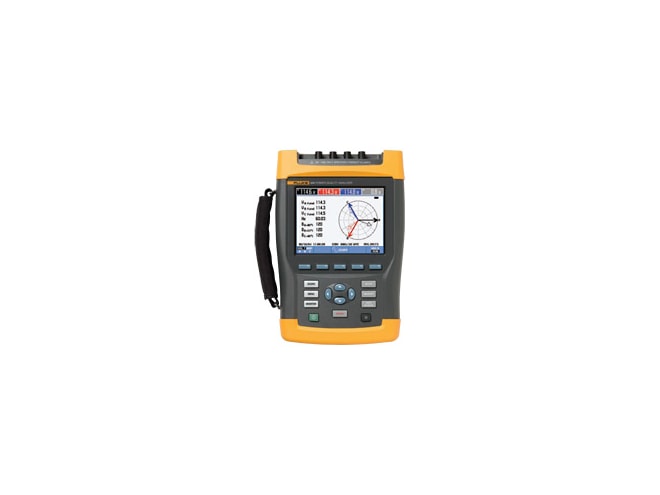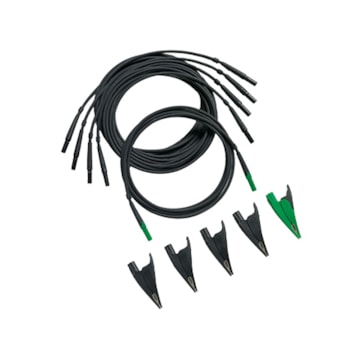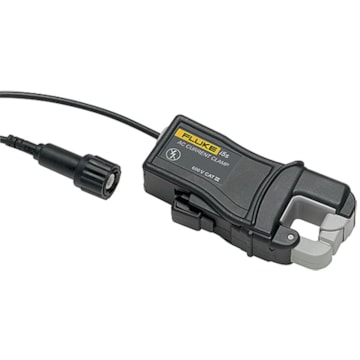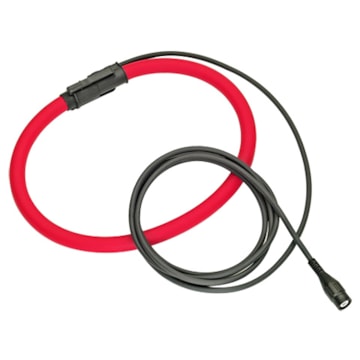
Fluke 430 Series Three-Phase Power Quality Analyzers
Pinpoint power problems faster, safer and in greater detail.

Overview
Features
- 600 V CAT IV/1000 V CAT III rated
- Automatic Transient Mode
- Troubleshoot real-time
- IEC 61000-4-30 Class-A standard
- View graphs and generate reports
- Memory for over 400 parameters
- Up to ten power quality parameters
Description
The Fluke 434 and 435 three-phase power quality analyzers help you locate, predict, prevent and troubleshoot problems in three- and single-phase power distribution systems. Troubleshooting is faster with on-screen display of trends and captured events, even while background recording continues. The new IEC standards for flicker, harmonics and power quality are built right in to take the guess work out of power quality.
Designed to help protect you and your equipment, the Fluke 430 Series analyzers and accessories are all certified to meet the stringent standards for use in CAT IV 600 V and CAT III 1000 V environments. They are the first tools of their kind to carry the CAT IV rating for use in power connections and outlets throughout a low-voltage power distribution system.
AutoTrend feature provides fast insight into changes over time. Every displayed reading is automatically recorded without having to set thresholds or intervals. Analyze the trends using the cursors and zoom tools—even while background recording continues.
The Fluke 435 is fully compliant with the new IEC 61000-4-30 Class-A standard. With this powerful capability, all measurements will be consistent and reliable in accordance with the latest international standard.
Power quality measurement is a relatively new, and quickly evolving field. There are hundreds of manufacturers around the world with unique measurement methodologies. Whereas basic single- and three-phase electrical measurements like rms voltage and current were defined long ago, many power quality parameters were not previously defined, forcing manufacturers to develop their own algorithms. With so much variation between instruments, electricians tend to waste too much time trying to understand an instrument's capabilities and measurement algorithms instead of understanding the quality of the power itself!
The new IEC 61000-4-30 Class-A standard takes the guesswork out of selecting a power quality instrument. The standard IEC 61000-4-30 defines the measurement methods for each parameter to obtain reliable, repeatable and comparable results. In addition, the accuracy, bandwidth and minimum set of parameters are all clearly defined.
Measure true-rms and peak voltage and current, frequency, dips and swells, transients, interruptions, power and power consumption, peak demand, harmonics up to the 50th, interharmonics, flicker, mains signaling, inrush and unbalance.
User-configurable, long-term recording of MIN, MAX and AVG readings for up to 100 parameters on all 4 phases. Enough memory is available to record 400 parameters for up to a month with 10 minute resolution, or capture smaller variations with resolution down to 0.5 seconds.
Every time an event or voltage distortion is detected, the instrument triggers and automatically stores voltage and current waveforms on all three phases and neutral. The analyzer will also trigger when a certain current level is exceeded. Up to 40 dips, swells, interruptions and transients can be captured this way. You can see voltage transients as high as 6 kV and as fast as 5 microseconds.
A single push of the MONITOR button delivers a dashboard display of rms voltage, harmonics, flicker, interruptions, rapid voltage changes, swells, unbalance, frequency and mains signaling. The dashboard is updated live, showing compliance of each parameter to EN50160 limits or your own limits. Color-coded bars clearly show which parameters are inside (pass) or outside limits (fail). During a monitor session, you can easily drill down to more detail of any parameter to view and capture its trend for a report.
The Fluke 430 Series provides three ways to analyze measurements. Cursors and zoom tools can be used ‘live' while taking measurements, or ‘off line' on stored measurement data. Additionally, the stored measurements can be transferred to a PC with the included software to perform custom analysis and create reports. Measurement data can also be exported to common spreadsheet programs. Store up to 10 measurement datasets and up to 50 screen captures for use in reports.
Applications include:
- Frontline troubleshooting
- Predictive maintenance
- Quality of service compliance
- Long-term analysis
- Load studies
- Energy assessments
Documents
Accessories
Need Help? Call a Temperature engineer at 1-800-884-4967
We're open 8:00 am to 5:30 pm ET











